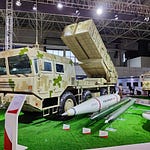
Overview:
An F/A-18 Super Hornet was recently seen with an SM-6 missile mounted under its wing. The SM-6 began its career as a surface-to-air missile utilized by ships in anti-air operations, which according to Wikipedia range from “intercept[ing]…high altitude or sea-skimming anti-ship missiles, performing terminal phase ballistic missile defense. [while] also function[ing] as a high-speed anti-ship missile.”

Combat Record
On December 26 2023, the first intercept of a ballistic missile in combat was performed by the SM-6 when the USS Laboon shot down three anti-ship ballistic missile in the Red Sea fired by Houthi rebels with multiple SM-6.
On January 30, 2024, the USS Carney shot down an anti-ship ballistic missile in the Gulf of Aden fired by Houthi rebels with an SM-6. This was the first combat interception of a ballistic missile publicly acknowledged by the DoD.
Speculation Multi-Role Air Defense and Interception:
With a range of between 130-200 nautical miles depending on intercept or strike application when launched from at-sea, these tests may indicate a desire by the U.S. Navy to perform multiple missions:
Quickly develop an ultra-long-range Air-to-Air missile:
A missile with a proven record of terminal ballistic intercepts at high speeds can apply to corner cases of intercepting slower moving aircraft. The missile’s longer range allows for quicker integration and implementation to catch up with China’s PL-17, which is purported to have a similar range as the SM-6
The Ship-launched version of the missile has been confirmed to be used for:
For air defense against fixed-/rotary-winged targets and anti-ship missiles operating at altitudes ranging from very high to sea-skimming, provide Sea-Based Terminal capability against short- and medium-range ballistic missiles in their terminal phase of flight…and provide extended range over-the-horizon capability against at-sea and overland threats
Per Naval News:
The SM-6 uses an X-band receiver for guidance purposes, so guidance by F/A-18E/F AN/APG-79 or F-35C AN/APG-81 AESA radars is possible. In practice, forward-based F-35C fighters could guide the missiles to target while less survivable Super Hornets launch them from safe distances. Super Hornets also have the ability to communicate fire control data through the Navy’s Naval Integrated Fire Control–Counter Air (NIFC-CA) datalink system.
Strike against Ships - The SM-6 was tested in 2016 against the decommissioned USS Reuben James Frigate back in 2016, sinking it. With a listed speed of Mach 3.5, the missile’s long range allows it to be used as a standoff multi-use strike missile for multiple types of targets - Ship/Surface or Land
Hypersonic missile interceptions through the use of aircraft
With an estimated speed of Mach 3.5 according to Wikipedia, the SM-6 has been utilized already in terminal phase intercepts against ballistic missiles (Mentioned earlier).
This capability would now be available for use in U.S. aircraft
Based on the photos: the 1st stage booster removed, indicating a desire to possibly reduce weight to be carried by the aircraft. The 1st stage booster helps the missile get up to altitude and speed but being carried aloft by an aircraft places the missile into ideal conditions already, eliminating the need for the booster. The longer range of aircraft then can give the missile an extended range of use as opposed to the sea-based version.
Implication:
An F/A-18 Super Hornet was recently seen with an SM-6 missile mounted under its wing. The SM-6 is a multi-purpose missile for air-to-air engagements against aircraft, missiles, ships, and surface targets:
The SM-6’s high speed and fragmentation warhead work well against multiple types of targets when combined with the missile’s relative high speed of Mach 3.5.
The missile’s extended range allow for the U.S. to quickly catch up with China’s recent developments of their own extended long-range missile, the PL-17.
All of this combined with the missile’s proven combat record and capabilities against short range and theater-level Ballistic missiles in terminal intercepts, would provide a quick and common-sense solution to integrate for U.S. Naval aircraft.
References:
U.S. Navy F/A-18 Super Hornet Spotted With SM-6 Missile Under Its Right Wing - The Aviationist
Air-launched SM-6 Spotted Again on U.S. Navy F/A-18 Super Hornet - Naval News
RIM-174 Standard ERAM - Wikipedia
Navy’s SM-6 Missile Used In Combat: Report | The War Zone (twz.com)
Anti-Aircraft Missile Sinks Ship: Navy SM-6 - Breaking Defense
russian_and_chinese_combat_air_trends_whr_final_web_version.pdf (rusi.org)
Massive PL-17 Air-To-Air Missile Seen On Chinese J-16 Fighters (twz.com)












Share this post